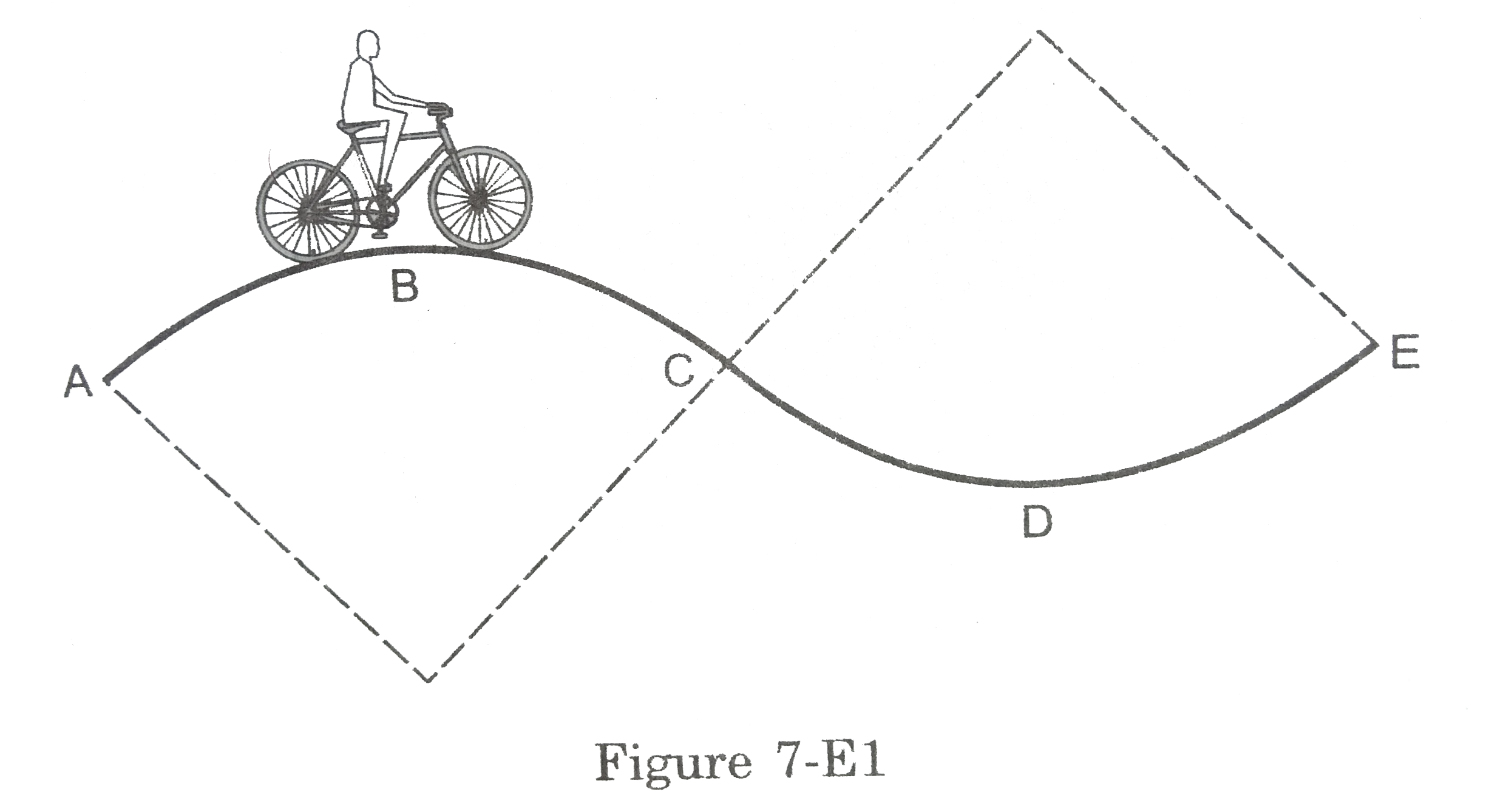A track consists of two circular pars ABC andCDE of equal rdius 100 m and joined smoothly as shown in figure.Each part sutends a right ngle at its centre. A cycle weighing 100 kg together with rider travels at a constant speed of 18 km/h on the track. A. Findteh nromal contct force by tehroad on the cycle whenit is at B and at D. b.Findteh force of friction exerted by the track on the tyres when the cycle is at B,C and D. c. Find the normal force between teh road and teh cycle just before and just after the cycle crosses C. d. What should be the minimum friction coefficient between the road and the tyre, which will ensure that teh cyclist can move with constant speed? Take g=10ms2

The correct Answer is:A, B, C, D
Radius of the curves =100 m <br>Weight=100kg<br>velocity=18kmhr=5msec<br>a.AtB,mg−mv2r=N
→N=(100×10)−(100×25100)
=1000−25=975N
At D,N=mg+mv2R
=1000+25=1025N
b.At B & D, the cycle has no tendency to slide.
So at B & D frictioN/Al is zero. At C mgsinθ=f
→1000×(1√2)=707N
c.iBeforeCmgcosθ−N=mv2r
→N=mgcosθ−mv2r
=707-25=682N<br>ii.N-mgcostheta=(mv^2)/r<br>rarr N=(mv^2)/r+mgcostheta<br>=25+707=732N<br>d.Tof∈douttheminiμmdesiredcoefficientofictionwehave→consrap∮justbeforec(whereNisminiμm).<br>NOwmuN=mg sintheta<br>rarr muxx682=707<br>So,mu=1.037
Topper's Solved these Questions
- CIRCULAR MOTIONBOOK - HC VERMACHAPTER - CIRCULAR MOTIONEXERCISE - Objective 2
7 Videos
- CENTRE OF MASS, LINEAR MOMENTUM, COLLISIONBOOK - HC VERMACHAPTER - CENTRE OF MASS, LINEAR MOMENTUM, COLLISIONEXERCISE - Exercises
64 Videos
- FLUID MECHANICSBOOK - HC VERMACHAPTER - FLUID MECHANICSEXERCISE - Exercises
35 Videos
Similar Questions
A track consists of two circular pars ABC andCDE of equal rdius 100 m and joined smoothly as shown in figure.Each part sutends a right ngle at its centre. A cycle weighing 100 kg together with rider travels at a constant speed of 18 km/h on the track. A. Findteh nromal contct force by tehroad on the cycle whenit is at B and at D. b.Findteh force of friction exerted by the track on the tyres when the cycle is at B,C and D. c. Find the normal force between teh road and teh cycle just before and just after the cycle crosses C. d. What should be the minimum friction coefficient between the road and the tyre, which will ensure that teh cyclist can move with constant speed? Take g=10ms2

View SolutionA track consists of two circular parts ABC and CDE of equal radius R and joined smoothly as shown. Each part subtends an angle 2θ at center. A vehicle of mass m travels with constant force by the road on the vehicle when it is at (i) B (ii) D (iii) just before C and (iv) just after C. (b) find the friction by the track on the vehicle when it is at B, C and D. (c) what should be the minimum friction coefficient between the road and the vehicle, which will ensure that cyclist can move with constant speed.

View Solution
Knowledge Check
If a stone of mass 0.05 kg is thrown out a window of a train moving at a constant speed of 100 km/ h then magnitude of the net force acting on the stone is
A0.5 NBzeroC50 ND5 NIn the figure shown, the force of friction between A and B will be :
 A70NB60NC50ND20N
A70NB60NC50ND20NA 100kg car is moving with a maximum velocity of 9m/s across a circular track of radius 30 m . The maximum force of friction between the road and the car is
A1000NB706NC270ND200N
A cyclist moving on a circular track of radius 100 m completes one revolution in 4 minutes What is his average speed ?
View SolutionA vehicle is moving on a track with constant speed as shown in figure. The apparent weight of the vehicle is

View SolutionAt what should a highway be banked for cars travelling at a speed of 100 km/h if the radius of the road is 400 m and no frictional forces are involved?
View SolutionTwo trains are moving at speeds 80 km/h and 100 km/h on parallel tracks in the same direction. From this information, one can say that
View SolutionA car runs at a constant speed on a circulat track of radius 100m. Taking 62.8s for every circular lap. The average velocity and average speed for each circular lap respectively are :
View Solution
